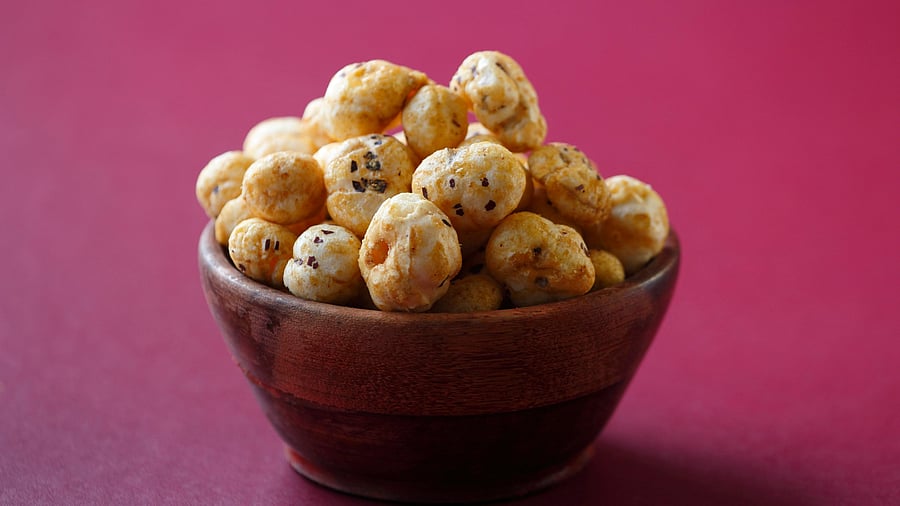
Credit: Special Arrangement
During the 2023–2024 fiscal year, India exported approximately 25,130 metric tonnes of makhana. This quiet aquatic crop from Bihar, once confined to religious offerings and fasting rituals, now features on airline menus and gourmet store shelves across the world. The rise of makhana, or fox nut, as a global superfood is the result of deliberate promotion and growing consumer interest.
Traditionally consumed during religious fasts, makhana has been cultivated in the Mithilanchal region of Bihar for over two centuries. Its sattvic and energy-boosting qualities, along with its low-fat content and richness in protein, carbohydrates, and essential minerals like magnesium, iron, phosphorus, and potassium, make it a highly nutritious food. Makhana is used in a variety of preparations—from kheer and curries to roasted snacks. The seed is also valued in traditional industries for starching fine textiles, including Banarasi sarees. Its cultural and nutritional significance reflects an intricate interplay of health, heritage and identity. As lifestyle diseases rise and traditional foods gain renewed relevance in modern diets, makhana’s role is being redefined.
Grown in shallow, stagnant water bodies — primarily in Darbhanga, Madhubani, and Purnia districts — makhana’s journey begins with sowing in early summer. After the flowers bloom and seeds sink to the bottom, skilled divers harvest them using traditional bamboo tools. This process is not only physically demanding but also requires generational knowledge and expertise.
The harvested seeds are sun-dried, roasted at temperatures up to 320 degrees Celsius, tempered for several days, and finally popped using a wooden mallet—a high-skill, time-sensitive step. If not done correctly, it results in inferior quality. The entire sequence— from sowing to popping — is artisanal, involving minimal modern technology.
India produces between 100,000 and 120,000 metric tonnes of makhana seeds annually. Nearly 85% is consumed domestically; the rest is exported, mainly to the United States, the United Kingdom, Singapore, Canada, and Australia. Initially popular among the Indian diaspora, makhana has gained wider acceptance among health-conscious global consumers.
Its rising visibility in health stores, e-commerce platforms, and urban pantries reflects a shift toward mindful eating
—and an opportunity to transform local livelihoods through global awareness.
Makhana’s rise to superfood status is driven by the timely convergence of nutritional science and shifting consumer preferences. Gluten-free and rich in antioxidants, it aligns with current health trends. The rising demand for functional foods has created a niche where makhana fits perfectly.
The Indian makhana market, valued at Rs 8.5 billion in 2024, is projected by IMARC Group to grow at a CAGR of 9.22% and reach Rs 19.6 billion by 2033. Health food brands have seized the opportunity: Haldiram’s and The Whole Truth are launching gourmet variants, while startups like TagZ Foods and Phab are offering protein-enriched and flavoured options. Even IndiGo Airlines now serves makhana as a premium in-flight snack. From airport lounges to wellness kits and gym bags, the superfood’s appeal continues to grow.
Its lightweight, shelf-stable nature makes it easy to market globally. More importantly, its alignment with plant-based, vegan, and Ayurvedic lifestyles secures its place in the future of food, turning it into a symbol of both health and heritage.
Recognising makhana’s potential, both central and state governments have launched significant initiatives, including the Pradhan Mantri Formalisation of Micro Food Processing Enterprises Scheme. In 2022, makhana received a GI tag, further boosting its market visibility. It was also designated as the ‘One District One Product’ in six districts of Bihar. To streamline institutional support, the 2025-26 Union Budget proposed the creation of a dedicated Makhana Board and a National Institute of Food Technology, Entrepreneurship, and Management in Bihar. These policy measures have helped establish a supportive ecosystem, contributing significantly to export growth.
Integrating makhana in school nutrition programmes, midday meals, and wellness packages could enhance both its visibility and nutritional impact. Celebrity endorsements, culinary festivals, and regional branding campaigns can further elevate its image — spotlighting its journey from ‘pond to plate’ and helping it become not just a health food, but a household staple.
With the right ecosystem—empowered farmers, informed consumers, responsive governance, and responsible businesses—makhana can contribute meaningfully to economic growth. It holds the promise and potential to drive India’s sustainable agricultural revolution forward.
(The writer is an associate professor, Department of HRM&GM, Ramaiah Institute of Management)